浅析中美消费观念的差异
浅析中西方主流消费理念差异
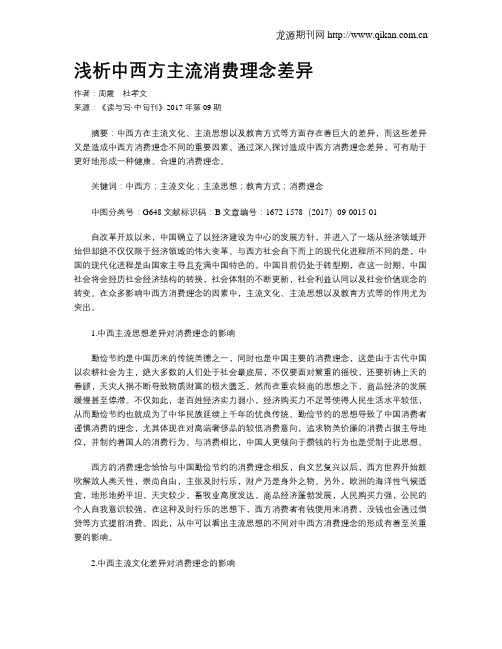
浅析中西方主流消费理念差异作者:周霞杜孝文来源:《读与写·中旬刊》2017年第09期摘要:中西方在主流文化、主流思想以及教育方式等方面存在着巨大的差异,而这些差异又是造成中西方消费理念不同的重要因素。
通过深入探讨造成中西方消费理念差异,可有助于更好地形成一种健康、合理的消费理念。
关键词:中西方;主流文化;主流思想;教育方式;消费理念中图分类号:G648文献标识码:B文章编号:1672-1578(2017)09-0015-01自改革开放以来,中国确立了以经济建设为中心的发展方针,并进入了一场从经济领域开始但却绝不仅仅限于经济领域的伟大变革。
与西方社会自下而上的现代化进程所不同的是,中国的现代化进程是由国家主导且充满中国特色的,中国目前仍处于转型期,在这一时期,中国社会将会经历社会经济结构的转换,社会体制的不断更新,社会利益认同以及社会价值观念的转变。
在众多影响中西方消费理念的因素中,主流文化、主流思想以及教育方式等的作用尤为突出。
1.中西主流思想差异对消费理念的影响勤俭节约是中国历来的传统美德之一,同时也是中国主要的消费理念,这是由于古代中国以农耕社会为主,绝大多数的人们处于社会最底层,不仅要面对繁重的徭役,还要祈祷上天的眷顾,天灾人祸不断导致物质财富的极大匮乏。
然而在重农轻商的思想之下,商品经济的发展缓慢甚至停滞。
不仅如此,老百姓经济实力弱小,经济购买力不足等使得人民生活水平较低,从而勤俭节约也就成为了中华民族延续上千年的优良传统。
勤俭节约的思想导致了中国消费者谨慎消费的理念,尤其体现在对高端奢侈品的较低消费意向,追求物美价廉的消费占据主导地位,并制约着国人的消费行为。
与消费相比,中国人更倾向于攒钱的行为也是受制于此思想。
西方的消费理念恰恰与中国勤俭节约的消费理念相反,自文艺复兴以后,西方世界开始鼓吹解放人类天性,崇尚自由,主张及时行乐,财产乃是身外之物。
另外,欧洲的海洋性气候适宜,地形地势平坦,天灾较少,畜牧业高度发达,商品经济蓬勃发展,人民购买力强,公民的个人自我意识较强,在这种及时行乐的思想下,西方消费者有钱便用来消费,没钱也会通过借贷等方式提前消费。
中美消费观差异的背景和意义
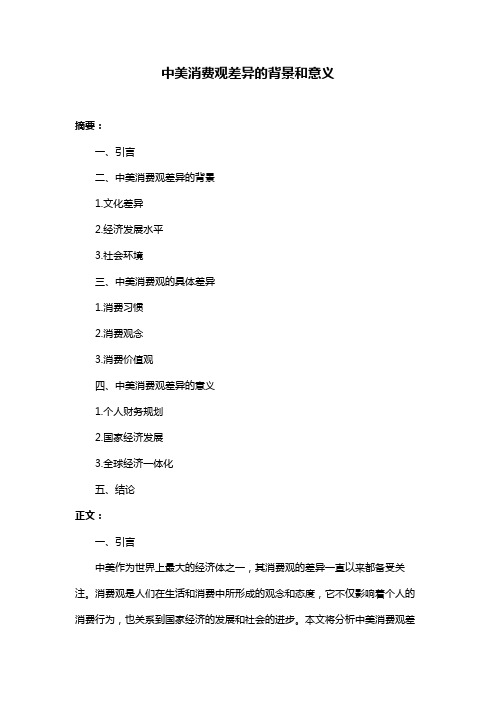
中美消费观差异的背景和意义摘要:一、引言二、中美消费观差异的背景1.文化差异2.经济发展水平3.社会环境三、中美消费观的具体差异1.消费习惯2.消费观念3.消费价值观四、中美消费观差异的意义1.个人财务规划2.国家经济发展3.全球经济一体化五、结论正文:一、引言中美作为世界上最大的经济体之一,其消费观的差异一直以来都备受关注。
消费观是人们在生活和消费中所形成的观念和态度,它不仅影响着个人的消费行为,也关系到国家经济的发展和社会的进步。
本文将分析中美消费观差异的背景和具体表现,并探讨这些差异的意义。
二、中美消费观差异的背景1.文化差异中美文化背景的差异是造成消费观不同的主要原因。
中国传统文化强调节俭、谦逊,注重家庭和集体利益;而美国文化则强调个人主义、自由和追求物质享受。
这些文化差异在消费观上得以体现。
2.经济发展水平经济发展水平是影响消费观的重要因素。
美国作为世界上最发达的国家之一,消费水平较高,人们更注重享受当下;而中国虽然近年来经济发展迅速,但人均收入水平仍有一定差距,因此人们在消费时会更加注重实用性和经济性。
3.社会环境社会环境对消费观的影响也不容忽视。
美国社会竞争激烈,人们为了提高生活品质,往往通过消费来展示自己的地位和实力;而中国社会则更注重家庭和亲情,消费观念相对较为保守。
三、中美消费观的具体差异1.消费习惯在中美两国的消费习惯上,中国人更注重节俭和储蓄,习惯于根据自己的收入水平进行消费;而美国人则更倾向于借贷消费,提前享受生活。
2.消费观念在消费观念上,中国人注重长远规划和家庭利益,消费行为往往受到家庭、子女教育和养老等因素的影响;而美国人的消费观念则以个人为中心,更关注当下的生活品质。
3.消费价值观在消费价值观方面,中国人重视面子和人际关系,消费时会考虑到他人的感受;而美国人的消费价值观则以个人喜好和需求为主,较少受到他人意见的影响。
四、中美消费观差异的意义1.个人财务规划中美消费观差异在个人财务规划方面具有重要意义。
关于中美消费观差异的参考书籍

近年来,中美两国的消费观念差异日益受到关注。
中美两国的消费市场、消费行为和消费心态存在着一些明显的差异,这一现象引起了学者们的浓厚兴趣。
针对中美消费观差异的研究逐渐成为学术界的热门话题。
为了深入了解中美消费观差异的相关内容,我在以下书籍中找到了宝贵的研究资料,特此推荐给大家。
第一、《中美消费观念差异研究》该书由著名学者合著,系统地探讨了中美两国消费观念差异的相关问题。
书中首先对中美两国的消费文化进行了比较分析,揭示了中美消费文化的根本差异。
深入剖析了中美用户的心理差异,从文化、历史和社会背景等多个角度进行了综合分析。
书中还通过大量的案例分析和数据支持,论证了中美消费观念差异对市场营销策略的影响。
该书总结了大量的实证研究成果,对中美消费观念差异进行了全面深入的解读,具有较高的学术价值。
第二、《我国消费:文化、社会和历史》该著作是关于我国消费文化的经典之作,书中深入探讨了我国消费行为、观念和心态的历史渊源。
作者结合我国的传统文化和现代社会,对我国消费方式进行了全面分析。
与此书中也对我国消费观念与西方国家的差异进行了深入比较。
通过对我国消费观念的全景式展示,使读者能够更加清晰地认识我国消费文化的特点和独特之处。
该书对于理解我国消费观念的形成和发展具有重要意义,也为研究中美消费观念差异提供了深刻启示。
第三、《美国消费心理学》这本书系统地阐释了美国消费心理学的相关理论和研究成果。
书中通过对美国用户心理特点的深入探讨,揭示了美国用户的消费动机、决策机制和行为模式。
作者还通过大量的案例和实证研究,展示了美国消费心理学在不同场景下的表现和特点。
通过学习这本书,读者能够更加全面地了解美国用户的行为逻辑和心理特征,从而有助于从理论上理解中美消费观念差异的本质。
第四、《跨文化营销:理论与实践》该书系统地阐述了跨文化营销的理论框架和实践方法。
在对不同国家和地区的消费文化进行深入比较的基础上,书中提出了针对不同文化环境下的营销策略与方法。
议论文西方消费观念-中西方消费观念差异

议论文西方消费观念:中西方消费观念差异近年来,受以美国为代表的西方消费主义的生活方式的影响,我国居民不论收入水平的高低对收入越高,消费的商品越多。
接下来小编为你带来议论文西方消费观念,希望对你有帮助。
议论文西方消费观念篇1中国人崇尚勤俭持家,量入为出,习惯于存款消费。
而西方人尤其是美国人则主张超前消费,习惯于贷款去享受生活。
有这样一个故事,讲的是一个中国老太太和一个美国老太太在天堂相遇,谈起了各自在人间的一生。
美国老太太到银行贷款买房,住了30年,最后贷款也还清了,并享受了一辈子的快乐生活。
中国老太太在年轻时,他母亲去世了,为他留下了刚买的房子,让她享受了30年;最后,她也为自己的女儿留下了一套新房。
听完了这个故事,我们应该能够大概了解中美消费观念里体现的文化差异,以及与此相关的社会伦理和社会价值观念等方面的差异。
美国老太太贷款住上了新房,舒舒服服地生活了一辈子;中国老太太也有自己的新房住,也能享受人生,不过住的是她母亲的房子。
从这个故事中可以看出美国人是自己享受生活,自己管自己,认为儿孙自有儿孙福而中国人崇尚的前人载树,后人乘凉,非常关心自己下一代的幸福生活。
造成这种差异的原因是多方面的。
因为从古自今,美国人相信上帝,认为他会给每个人赐福,所以美国人崇尚公平,认为自己的事情自己去做,不要想有别人的帮助;而中国人尊住祖,认为是祖先给子孙赐福,是祖先在保佑着你,所以中国人崇尚伦理亲情。
中西消费观念的差异,取决于各自不同的伦理亲情于价值观念。
随着文化更加广泛、更加频繁、更加激烈、更加深入地接触与碰撞,中西方也会多向的、多层次的互动和吸纳对方的优秀文化,中国人在子女留下财富的同时,也会接受贷款消费,而美国人也会更加注重伦理亲情。
议论文西方消费观念篇2随着经济社会的不断发展,人们的生活水平提高了,消费能力自然上升,消费观念也在发生变化。
此时,为了促进国家和自身的共同发展,正确的消费观就起了重要作用。
首先,要有促进消费增长的意识,这是必须的。
从文化层面分析中美消费观念的差异
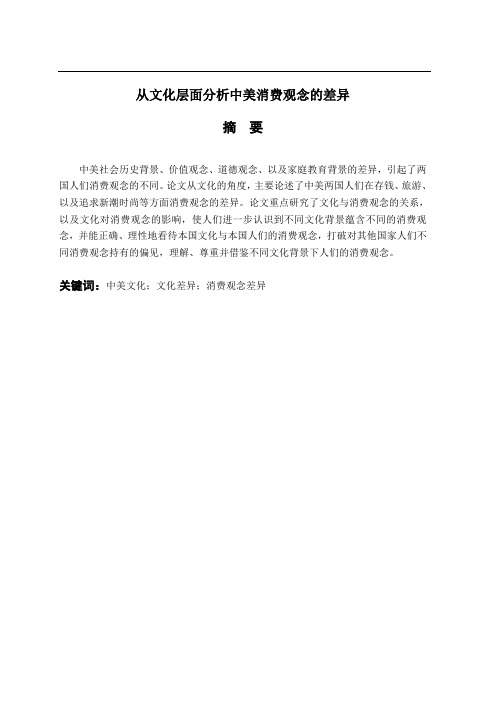
从文化层面分析中美消费观念的差异摘要中美社会历史背景、价值观念、道德观念、以及家庭教育背景的差异,引起了两国人们消费观念的不同。
论文从文化的角度,主要论述了中美两国人们在存钱、旅游、以及追求新潮时尚等方面消费观念的差异。
论文重点研究了文化与消费观念的关系,以及文化对消费观念的影响,使人们进一步认识到不同文化背景蕴含不同的消费观念,并能正确、理性地看待本国文化与本国人们的消费观念,打破对其他国家人们不同消费观念持有的偏见,理解、尊重并借鉴不同文化背景下人们的消费观念。
关键词:中美文化;文化差异;消费观念差异On the Differences of Chinese and American Consumption Conceptions from the Perspective of CultureABSTRACTOwing to the geography differences, society development differences, cultural value differences, ethic differences, family education differences, Chinese and American nations’ consumption conceptions differ from each other in three aspects: difference in depositing conception, difference in traveling consuming, and difference in catching fashion. This study mainly elaborates on the relationship between culture and consumption, emphasizing the cultures’ influence on consumption conception from the perspective of culture. The aim of this thesis includes three aspects: firstly, making people view their own culture and consumption conception correctly and rationally; secondly, breaking people’s prejudice towards other nation’s consumption conception; finally, making people understand, and respect people’s consumption conception under different cultures.Key words:Chinese-American culture; culture difference; consumption conception differenceCONTENTS1 Introduction (1)2 Chinese and American Culture Differences (3)2.1 Geography differences (3)2.2 Society development differences (4)2.3 Cultural value differences... . (4)2.4 Ethics differences (5)2.5 Family education d ifferences (6)3 Chinese and American Consumption Conception Differences (7)3.1 Difference in depositing conception (7)3.2 Difference in traveling consuming (8)3.3 Difference in catching fashion (8)4 Influences of Different Cultures on Consumption Conceptions (10)4.1 Influence of geography on consumption conception (10)4.2 Influence of society development on consumption conception (11)4.2 Influence of value on consumption conception (11)4.3 Influence of traditional family education on consumption conception (13)Conclusion (15)References (16)Introduction“Culture is the total accumulation of beliefs, values, behaviors, institutions and communication patterns that are shared, learned and passed down through the generations in identifiable group of people.”(Che Lijun, 2008:3) It is a well-known fact that people across nations and countries have different cultures, which influence human life in various aspects. Besides, consumption conception is one of the deepest aspects being influenced. Owing to the different cultures of China and America, their society and history differences, cultural value differences, ethics differences, and family education differences, the consumption concept of Chinese and American is also different in three aspects: depositing conception aspect, traveling consuming aspect, catching fashion aspect.Until now, many Chinese and foreign scholars, such as Zhu Chen (1996), Chen Qinde(2005) , Miao Qing(2005) , Hao Peiyan(2007) , Yang Guangqiong (2008) have ever done researches on Chinese- American culture differences and Chinese-American consumption conception differences . But each of them approaches it in his own way without keeping abreast of what others are doing on the study of culture and consumption concept. The former studies, which haven't combined culture differences with consumption conception differences, may cause some misunderstanding which can't make people achieve a better understanding of the relationship between culture and consumption conceptions. Based on the researches of the previous experts and scholars, this paper is to make a systematic study on the differences of Chinese-American consumption conceptions from cultural respect. This paper has five parts:The first part is an introduction. It shows readers the relationship between culture and consumption conception. The second part mainly analyses Chinese-American culture differences from geography, society development, value, ethics and family education aspects. The third part will talk about Chinese-American consumption conception differences from three aspects. The fourth part concerns with different culture's influences on consumption conception. The final part serves as a conclusion. It draws a conclusionthat the nature of consumption is culture. Only having a good knowledge of culture differences can we evaluate people's consumption conception correctly.2 Chinese and American Culture Differences“Culture usually means the unique life form in a particular society, including ideas, recognition, emotion, and behavioral faith, which are different from those of other society.”(Che Lijun, 2008:2) In our daily life, culture is ubiquitous, multidimensional, and all-pervasive, as we have it almost anywhere and anytime. It is understood differently by people throughout the world .Americans believe that culture is a fast-moving train, which is closely connected with what is going on for the time being .The better you adjust to the present world, the more you understand culture .However, Chinese people believe that culture is closely related to the past .The more you know about Confucianism or the past, the more cultured you are consider to be. To the outside observers, Americans may seem like a nation of amnesiacs; they care more about the next big invention. To Chinese, the past is always something to be memorized. They are always proud of the four great inventions they made in ancient times. Therefore, the culture differences between China and America are various, which may be reflected from the following aspects:2.1 Geography differencesChina and America have different geography conditions. America has a vast territory; and most territory physiognomy is low and flat. It lies in the temperate zone where there is enough rain. It supplies good resource condition for the development of American agriculture and has no limit to its development. It also has abundant water resource, which supplies reliable security for the development of American industry and resident usage. The mineral and energetic sources are also very rich, such as iron, copper, lead, zinc, mine, petroleum and natural gas etc. For China, remote location, and the relatively closed environment are the significant features. Geographic environmental conditions in China just like this: in the West and the North, there are plateau, mountains and desert, while in the East and the South, there is sea. All of these are barriers for Chinese.2.2 Society development differencesWe all know that America is an immigration country, where people have adventure spirit. Its history is very short, for about 300 years .For this, we would have to turn to the historical development of the United States. Its origins can be traced back to the 1776. In 1776, the US gained independence from the British rule. After 200 years of development, the United States has developed far beyond its previous in the aspects of economy, politics and military power. After the disintegration of the Soviet Union, the United States has become the sole superpower in the world. American is also the first modern democracy country in the world. With prosperous industry, America’s economy is full of vigor, which excludes the natural economy prematurely and breaks the self-sufficient pattern.However, China, as a feudal society with closed natural economy, has developed for about thousands of years.Its self-sufficient producing style forces most Chinese to spend all their life on farming. Once someone lost his ability of self-development or even lost his land, his family cannot survive.2.3 Cultural value differencesIn china, we pay much attention to a person’s reputation, modesty, advocate selfless-service and encourage people to make up for their defect and suffering by adjusting their inner mind. In Chinese history, Confucius concepts played a dominant role in the formation of social ideology. Confucianism believes that one should immerse into the whole society to exist. And one cannot realize his own value of existence if he does not immerse and become part of the society .China’s strong emphasis on the group, cooperation and coordination, in the process of social development, has built up their group-oriented value. As a basic value system, Confucianism has permeated all Asia for centuries .It is a philosophy of humanity which survives on the basis of good interpersonal relationship. “REN”(benevolence), one of its principles and the core of Confucianism, means the harmony of interpersonal passion .In daily life, it has intimate connection with mutual benefit which indicates that one must have the ability to think in other’s shoes, take care ofothers, and give sympathy to others. Another principle is “YI” (righteousness) which is part of human nature brings people back to “the good nature of humankind at beginning of birth”. It can make person see through problems and integrate with others by transcending the present interest and breaking through personal limitations. According to Confucianism, this kind of social relationship based on common interest, is very important and conductive to group coordination and harmonious interpersonal relation .So, in China, because of the high emphasis on group concept and social coordination, collectivism has gained a good and long –standing reputation.However, Americans focus on materials, and stress individualism. The unique experience of American history has determined the formation of their concept of individualism, the basis of American ideology. In order to escape the religious persecution from central Europe, the first group of settlers set up their own colony on the American continent .And this special historic experience of emphasizing on dependence has given a profound influence on American cultural value .In America, each person is viewed as having a unique set of talents and potentials. The striving for self –realization is accompanied by a subjective sense of rightness and personal well-being. Individualism also encourages people to express their own opinions and to make their own decisions independent of external influences.2.4 Ethics differencesChinese family moral education takes human relations as a foundation and emotions as principal to process family interpersonal relationship. Chinese family ethics are based on human relations, and they take emotion for the law to deal with family relationships. Chinese ties to each other with blood as basic coordinates. In dealing with family relations, the Chinese people’s genetic-based sentiments led to unusual attention. However, Chinese people have never followed a "reason" for the love, “A kind father and a filial son, a tender brother and a respecting brother, a gentle husband and a tender wife”(父慈子孝,兄爱弟敬,夫和妻柔) (Weienyase,2000:127))standard has enabled the Chinese to follow. Chinese families used to cultivate good habits and establish relationships of caring other people. Ittrains personality of each family member and at last units a family as a whole.However, American family moral education takes individual as the center. In an American family, individual is the foundation and has the highest value, whose existence does not rely on other people. The family may make all sorts of sacrifices for them, but does not request much obeying. The independent individual can enjoy freedom and equality in the family. The American parents foster and educate their children, but do not attempt any repayment. Children, after 18 years old, leave home to rent a room to live alone, to study or to work, and nobody can accuse the parents of their being unreasonable. Clearly, the common Chinese family stress and believe that, "good relationship is the most important"(和为贵).(Weienyase, 2000:9) American family stresses personality, and has strong rational idea.2.5 Family education differencesChinese family education takes "the benevolence of the Confucianism”as the core; the basic of benevolence is loving people. This enormously affirmed and transferred family member's intrinsic noble motive. In China, the corresponding relation of rights and duties are not important in China morality. When we fulfill our obligation, we make other people enjoy the rights. This is a basic faith of Chinese family.Americans take fair as the moral principle; everything is according with fair. And this “fair" is rational, even indifferent. American believes the fair is in opposition to and in agreement with the duty and the right. American is clear about the relation of the right and the duty. They work to get the reward, which also includes love. If they ask other people for help they also have to pay some reward. For example, they have paid for using relative's telephone, and the children demand the reward if they help their parents to wash car. American views that duty and right is not inconsistent with their intrinsic love. To pursue the coexistence of the right and the duty is the American family’s fair principle.3 Chinese and American Consumption Conception DifferencesConsumption conception means people’s ideology and attitude towards their disposable income, including people’s pursuit of the goods value. It also refers to a consumption activity, which makes people evaluate and value their action towards consumption manner, consumption process, and consumption trend. The process of shaping consumption conception is closely related to the level of productivity. Owing to the different level of productivity, the two nations’ consumption conceptions are different. The characteristics of Chinese consumption conceptions are conservative, with high saving rate. On the contrary, to most Americans, they tend to consume excessively. The main differences are as following:3.1 Difference in depositing conceptionAmerica is an emerging industrial country, without traditional agricultural period (while China is a large agricultural country), and therefore they do not have the conception of depositing money. Americans have courage to active advance.However, China, as a feudal society with closed natural economy, has developed for about thousands years. Chinese people from the very young has been instilled such a conception–to keep up. Since ancient times, Chinese society is also to appraise the economy, which is many Asians’ concept ion to money. To sum it up in one word that is "deposit." There is an old story that can best prove this phenomenon: it is about a Chinese old woman and an American old woman. When they were dying, the Chinese old woman said, “It took me 60 years to save enough money to buy a big house”, and the Western old woman said, “It took me 60 years to pay for the debt of my house”. (王埃亮,2000) We can see from the story that Chinese people traditionally think that they buy what they can afford and don’t want to be on a debt. However, Western people think that they would like to enjoy their lives even by loaning money from bank or making an installment. In myopinion, it’s a good idea for people to e njoy the life more comfortable while, we should also realize that the real happy life is contributed to the hard work by our own hands.3.2 Difference in traveling consumingAmerica is an immigrant nation. The development of the western region makes constant flow become a living. Therefore, American have no conception of the ancient precept "it is good to stay home for a thousand days ,and it is difficult to go out even for a moment(在家千日好,出外一时难)". With the development of family vehicle and highway, as well as other infrastructure industry and technology, travel becomes very simple. So tourism has become a major industry in America. However, Chinese advocate economy. They don’t think it very important to conduct cultural entertainment expense and service expense. In their point of view, traveling expense is also the service expense, which is spiritual expense, and it belongs to high income people. They also believe that, tourism expense is the expense after people’s basic life needs are satisfied; and at present, traveling is a kind of basic accumulation expense, but it is not a kind of regular expense. People think the traveling expends, especially traveling aboard is luxurious expense. To borrow money to travel, for most people in China is an incredible thing. In the eyes of most ordinary people, tourism consumption is not necessary in their lives.3.3 Difference in catching fashionAmerican likes to catch new things in order to be different. In America, Only the work- clothes have the possibility to be put on for above 3 years, the leisure clothes generally only are put on for 1 - 2 years. Moreover per capita has various seasons clothing above 10 sets. Their clothing is massively from Chinese and all developing nations, the price of which is extremely cheap.In the durable consumable aspect, the renewal speed is very quick. According to Sun Bangzhu’s investigation, the proportion of people having the cell phones is very high, nearly 100% university students, 50 - 70% middle-school students, 80% adults have cellphones, and after just one year they will get a new one. For automobile and other domestic electric products, they don’t use them until they can’t work. Therefore, in American life trash, we can see all kinds of things, such as refrigerator, air conditioner, television, and washer and so on.In the 80's, American pursued luxuriously. The majority of Americans have only the brand in mind, especially some young people; they didn’t put on clothes, which are the non- name brand. But in the 90's, American gradually has been faint in expense idea called brand consciousness, and the price consciousness is in the upper hand. However, Chinese are just on the opposite. Chinese consumers’expense behavior has two extremely remarkable characteristics: One is admiring fashion, displaying the new conception and new product craving, but the original product loyalty is low; the other is worshiping the psychology of foreign countries, favoring the purchase of international brand.4 Influences of Different Cultures on Consumption ConceptionIn sections two and three, we have explained in the different culture and consumption conceptions between China and America. So in this part we will mainly focus on how the culture influences the consumption conception.4.1 Influence of geography on consumption conceptionAmerica is an advanced agricultural country, which owns vast, low and flat territory, abundant water resource, and mineral and energetic sources.These sources are taking great grade in the world. Variety and rich resources also supply great foundation to the American industry and great production for consumption .Therefore; they don’t have the idea of depositingHowever, China, because of its relatively closed environment, it inevitably brings closure psychological and cultural anthropology. In China, the psychological and the marine cultural development do not play the important roles, which also related to the Huang - Huai basin, whose natural conditions is good for farming, so the people began to get active and formed a deep attachment to the land. Chinese people are lack of sufficient interest in the sea. Operations at sea are not only difficult but also dangerous, far less safe than agriculture. We assume that, in the low standard of living condition, the need of security should be quite strong. Since people have land for farming, so why do they seek danger? What’s more, the farming life also helps farmers like simple lifestyle and calm rhythm of life, and the sea-based trade will be disturbed and fast rhythm. China's natural conditions, climate, topography, and other aspects are not good for agricultural production, but in general far more favorable than negative. Given China’s own conditions, agriculture is the best choice. Chinese people have a deep sense of food .They think "food is the most important thing of people’s life”(民以食为天)" and "relying on the nature"(靠天吃饭)(李肖,2002)derived from the experience of agricultural life. Chinese food culture is full of life, which is a factor of fundamental aspect of people's life. This factor is constrained andarranged by the “nature”(天). Therefore, the farmers had to take into account the instable climate and mutations factors. The surplus grain will be stored up for the rainy day, and the Chinese community has always been a form of self-sufficiency. Therefore, Chinese people from the very young have been instilled to keep up such a conception. Since ancient times, Chinese society is also to appraise the economy, whi ch is many Asians’ concept ion of money. To sum it up in one word that is "deposit."4.2 Influence of society development on consumption conceptionWe all know that America’s neoteric economy is full of vigor. It breaks the self-sufficient pattern. Exploiting the world market and increasingly extending are all impacting the nation guard and limitation. Besides, America is an emerging industrial country, without traditional agricultural period (while China is a large agricultural country). Owing to these reasons, Americans do not have the conception of depositing money. They have the courage to advance. However, Chinese value agriculture more than industry and commerce. In China, two thirds of its population remains making a living on land. Old China is a feudal society with closed natural economy which has developed for thousands of years. Its self –sufficient producing style forces most Chinese to spend all their lives on farming. Once someone lost his ability of self-development or even lost his land, his family cannot survive. Owing to the difference of the society development, Chinese and American consumption conceptions are different. Americans don’t care much about depositing, while Chinese value it very much.4.3 Influence of value on consumption conceptionChinese highlight a person’s reputation, modesty, paying much attention to the spiritual consumption. They advocate selfless-service and encourage people to make up for their defect and suffering by adjusting their inner mind. For this, we could trace back to the origin of the traditional Chinese values. Confucianism as the mainstream of Chinese culture,along with Taoism and Buddhism, has established the framework of Chinese traditional culture and has built the mentality of the Chinese people. “Benevolence” is the core, and ethics is the standard. Adopted and reinforced by kings and governors since the Han Dynasty, especially in the Song and Ming dynasties, classic Confucianism became the theoretical pattern, whose ultimate concern was how to become a noble man or gentleman, how to cultivate one’s attitude or outlook. Confucius said: “the man with benevolence is the one who loves all men.”(Weienyase, 2000:69) The way to carry out benevolence is to establish others if one wants to establish oneself and to enhance others if one would enhance oneself. Do not do to others what you would not wish to be done yourself. The great learning teaches illustrious virtue, to improve the people, and to remain in the state of highest excellence. To achieve a moral ethics and improve one’s spiritual state as the Confucian ideals have made up of the core value of Chinese culture, due to which China becomes one of the cultural and economic centers of the ancient world. To the virtuous ancient Chinese, human interest and desires were of less important, and hence not worth pursuing.However, American is an interest-oriented country. They focus on material consumption. They consider it almost a right to be materially well off and physically comfortable. They expect swift and convenient transportation, a variety of clean and healthy food, and comfortable homes equipped with numerous laborsaving devices including both central heating and hot water. The government is expected to ensure access to food and drug products. Activities of all people and agencies can affect the public welfare. Associated with the values of physical comfort and health is the acceptance of cleanliness as being nearly identical with health. All the values of material property with material well-being yield the powerful social norm of progress. Progress may be said to be universal .Throughout the world, people wish for basic physical comfort, necessary material possessions, and good health and medical services that reduce the physical harshness of birth, disease and death .Both science and technology serve the value of progress .Based on this value, most Americans tend to believe that the basic problem of the world is economic and that technology offers solutions. Associated with material comfort,the American genius for devising and employing machines also provide efficiency and convenience in daily life .American advisors and technicians exhibit a strong tendency to perceive their tasks as requiring the use of machinery. Their future orientation creates a feeling that progress can make everything better than now. Americans find it important to cope with the flow “keeping up with the times” (Borden, George A) and to look ahead “keeping an eye on the future”, (Borden, George A) but the temporal orientation downstream should be qualified as “near future”. So most Americans feel that through their effort they can bring about a better future without compromising the welfare and progress of others .That there is enough for everyone is a valid belief for people living in a large country with an expanding economy and abundant recourses. With no restriction on the goods available to all, individuals can progress, that is, acquire a large quantity of the goods for themselves without concern for depriving others of the same opportunity. The Americans stress on material things is associated with a belief in the inviolacy of private property, a value commonly asserted to be at the root of the constitution and the American conception of democracy. They react negatively to the idea that free enterprises will be denied to anyone in the world .Americans regard free enterprises as an inalienable right that is worth fighting for. At the interpersonal level, many Americans also encounter difficulties in their dealing with persons who do not share with them a clear distinction between private and public property. On a large scale, Americans may react quite negatively to bribery of government officials and other methods of directing public funds into private pockets .With the scientific support of the theory of evolution, Americans see progress as ascending the primitive past along a path in time toward a future in which the impediments of nature are dominated by individual will and technology.4. 4 Influence of traditional family education on consumption conceptionParents in China are good at persuading. They attach importance to their children excessively. They even accept the obligation of educating their children without any complaint. In each stage, they protect children from hurt. For the benefit of the children, they try their best to solve the problems for children. Chinese children also respect the oldgeneration and their experience, and they are happy to accept the current experience of their parents. Today, Chinese parents give more attention to education than before. But they lack scientific educational ideas. Sometimes their ideas of children education are wrong. There is a universal phenomenon that Chinese parents lose the family education direction. People hope that their sons will grow up to be successful persons, which always causes children to feel tired of study, or even to give up the study. Both American family and Chinese family take moral education. In America, the children are cultivated the spirit of independence, and confidence. They explore these when they are young. The children have the right to choose what they want freely. Today, the children in US have more choices than their parents, but the complex situation makes it more difficult to make a decision. The parents do not make decisions for their children instead they give freedom to them. The last goal of American family education is to make children to be a useful person. The Americans give more encouragement than protections to the children .Americans encourage the children to make all kinds of attempt, which can raise their ability, interest, and the most important confidence.From the above analysis, we can draw the conclusion that family education has great influence on cultivating the consumption conception. Americans’education style makes them consume boldly. They have enough confidence to pay the debt. While for Chinese, we do anything hesitantly. And we like asking parents to give advice.。
中美边际消费倾向之比较

在关于消费理论的研究中,边际消费倾向备受关注,这不仅是因为它对消费函数的形成至关重要,也因为它是分析收入分配对总消费的影响的一个重要理论依据。
居民边际消费倾向就是指,居民家庭每增加一个人所增加的商品消费量。而边际消费倾向的提升就是指所增加的商品消费量在质和量的提高,或规模的扩展。居民消费具有不同的地域性,其收入与消费以及价格具有差异性。以表现为不同的特征。
我国居民边际消费倾向提升策略研究
中国贵阳政府门户网站 |更新时间:2009-01-13|来源:中经专网
字号:【大】【中】【小】 【复制本页地址】【打印本页】【关闭窗口】
[摘要]近年来,我国最终消费率和居民消费率都处于下降趋势。在当前宏观经济形势趋冷的背景下,提升居民消费水平具有特殊意义。本文对居民边际消费倾向的内涵和特征进行了阐述,并就当前国内外的研究现状进行了梳理。在此基础上,针对如何提升我国居民边际消费倾向提出了政策建议。
三、对策及建议
(一)把握好潜在经济增长率与适度消费增长区间
潜在经济增长率与适度消费增长区间的测算和把握,是正确分析经济波动态势的重要基础。所谓潜在经济增长率是指:在一定时期内,在各种资源正常限度地充分利用,且不引发严重通货膨胀的情况下,所能达到的经济增长率。潜在经济增长表明一定时期内经济增长的长期趋势。现实的经济运行和消费水平围绕潜在经济增长率上下波动。如果现实的经济增长率过高地超过了潜在经济增长率,则各种资源供给的瓶颈制约就会非常严重,经济运行就会绷得很紧,产业结构失衡,引发严重的通货膨胀,边际消费增长难以为继;反之,若现实的经济增长率过低地低于潜在经济增长率,消费率过低则失业问题不好解决,有可能带来通货紧缩,企业经营困难,国家财政收入减少,各项社会事业难以得到发展。现实的经济增长率以及消费水平可在一定的、适当的幅度内围绕潜在经济增长率上下波动,既不引起资源的严重制约,也不引起资源的严重闲置,物价总水平保持在社会可承受的范围内,这一波动可称为适度经济增长区和适度消费增长区。
中美消费观

美国人喜欢超前消费借贷消费,他们已经习惯了这种消费方式,并且已经形成了一种消费文化,这在某种程度上反映了美国人的价值观,讲究自由和物质增长,注重效率和实用主义,看重物质享受等。
一美国消费文化的特点美国人的生活方式,曾被美国媒体形容为:只要太阳一升起,消费者就开始购物。
美国人消费的主要特征是超前消费、借贷消费,即寅吃卯粮。
美国消费文化的主要特征是超前消费,由于政府消费政策的鼓励和社会风气的影响,美国人提倡超前消费,为了维持高消费的生活水平,疯狂工作已经不能满足他们的需要,他们开始向着借贷出发。
实际上,美国消费文化的产生和发展已经很长的历史,借贷消费也曾经受过伦理的谴责和社会的挑战,但慢慢的这一消费文化逐渐被所接受,这种消费文化曾经给美国经济的发展做出贡献,但是随着美国经济监管的不力,这种消费方式已经转变为抑制美国经济发展的瓶颈。
美国人信仰超前消费,并此而自豪。
美国大多数居民利用房屋抵押贷款的再融资来获得更多的贷款,以此维持自己的生活。
二美国消费文化的形成美国消费文化的形成经历着长期的变革,美国发展成为一个经济强国,历史上有很多人物做出了巨大的贡献,比如汽车大亨福特,他首次将大众消费和大规模生产结合起来,缓解了供过于求的矛盾,使美国的经济发展从以生产拉动经济为主转变为以消费刺激消费为主。
随着西方国家工业革命的完成,美国的消费文化已经基本形成,企业对消费的倡导和鼓励达到了前所未有的高度,美国政府更是鼓励人们大肆消费,住豪华的别墅,因此,刺激消费成为美国经济发展的一个重要支柱,消费甚至被当做一种爱国的行为。
即使没有钱,他们也可以借助借贷抵押或分期付款的方式来消费,美国人纷纷消费,极大的促进了美国经济的发展。
三从美国消费文化渗透出的价值观(一)物质享乐主义(二)个人成就感(三)努力工作(四)效率和实用主义(五)自由对于中国来说,中国的传统文化如中庸(自古儒家就有“中庸之道”之说)、重伦理、倡导道德至上、重人缘,倡导和谐统一(中国人相信人缘是一个人的巨大财富)等都对中国的消费心理和行为产生了影响:1、重储蓄:据统计59%的消费者把银行活期/定期存款作为最主要的理财方式。
浅析中美消费观差异

圜圈嘲
浅析 中美 消费观差异
.
王 峥
摘 要 : 近 年 来 中 美 两 国的 差 异 日益 缩 小 , 却 始 终 存 在 中国 , 孩子是家庭的一切 . 代表着希望 . 家 长 往 在着很 多不容忽视的差异 . 如 消 费观 念 的 不 同 : 美国 往 把 自己 的孩 子 当做 自己的 第 二 次 机会 . 去 竭 力 供 养 人 习惯 于超 前 消 费 . 而 中 国人 偏 爱 储 蓄 。 这 种 差 异 性 自己的子女使之成才 。同时在 中国的教育体 制下 . 子 表现在 方方面面 . 诸 如 购 买住 房 、 供 养 子 女 以及 享 受 女 的 教 育开 销 占据 了家 庭 大 部 分 的 开支 而美 国父 母 生 活 的 方 法 此 两种 消 费观 念 因其 多方 面 的 形 成 原 因 更 希 望 自己 的孩 子 通 过 自 己的 努力 . 例 如 打 工 或 做 家 不 同致使 其 各有 千秋 . 所 以 两 种 消 费观 念之 间 的 相 互 务 来 获得 额 外 的收 入 . 而不 是 直接 向父 母 索 要 学 习至 关 重要 ( 三) 享 受生 活— — 旅 游 和 时 尚 关键词 : 中 羡 消 费观 中美 价值 观 差异 美 国人 习惯 在 假 期 时 外 出 度假 . 这 可 以放 松 身 心 舒缓心情 。 并 且 增 加 家庭 成 员 之 间 的感 情 时 至 今 日 中美 消 费 观 的 差 异 性 伴 随 着 交通 业 的发 展 与 益 完 善 . 旅 游 变 得 越 来 越 简 美 国人 注重 生 活 质 量 . 性格开放 。 崇 尚享 乐 , 敢 于 单 。 致 使 旅 游 业 成 为 了美 国支 柱 型 产 业 之 一 而 在 中 花 明 天 的 钱 享 受 今 天 的 生 活 .是 超 前 消 费 的 典 型 代 国 . 旅游 则是一项奢侈活动 . 民众 通 常 只 有 在 满 足 所 表; 而 中 国 人 性 格 自古保 守 . 以 勤 俭 为美 德 , 他 们 习惯 有 基 础 需 求 之 后 才 予 以 考 虑 . 但 大 部 分 人 仍 不 能 轻 易 于 把 钱 存 起 来 以 备 不 时 之 需 .是 保 守 消 费 的 典 型 代 满 足地 生 活 基 本 需 求 . 所 以在 他 们 的 观 念 里 旅游 是 一 表 。据 报 道 , 截至 2 0 0 7年 底 , 美 国家 庭 部 门 负债 率 已 件 可 有 可 无 的活 动 飞 涨至可 支配个 人 收入 的 1 3 3 % . 比十 年 前 上 升 了 美 国人 喜 欢 追 求 新 鲜 事物 。据 一 项 调 查 表 明 : 在 4 0 %。( 严. 2 o l o ) 而 中 国 的 消费 率 一 直 低 于 国际 水 平 。 美国, 只 有 工 作 服 有 可 能 被 使 用 3年 以 上 . 平 常 的衣 且 呈 逐 年 下 降 的趋 势 据世界银行统计 . 上世纪 9 0年 服 最 多 穿 着 1 — 2年 .并 且每 一 个 季 节 的人 均 服 装 都 代 以来 . 世界各 国平 均消费率 稳定 在 7 3 %一 7 9 %, 一些 高 达 1 0套 以上 它 们 大 多 以低 廉 的 价格 从 发展 中 国 发 展 中 国家 的最 终 消 费 率 也 达 6 5 %一 7 O % . 而 中 国 的 家 引进 . 而 那些 国 际知 名 品牌 在 美 国的 售 价 也 相 对 较 最终消费率在 2 0 0 8年仅 为 4 8 . 6 %。 ( 严. 2 0 1 0 ) 低. 所 以尽 管 美 国 人 民 购 买 很 多 的 服 装 . 但 是 这 笔 开 卜一 ) 购 买 住 房 支 只 占他 们 收 入 的小 部 分 。 而 中 国 的 情 况 则 恰 恰 相 “ 当来 自中 国 和美 国 的两 位 老 妇 人 死 后 在 天 堂 相 反 。 随着 国际化的影响 . 很 多 国 际 知 名 品 牌 以高 昂 的 遇 时, 她 们 各 自谈起 了 自己 的整 个 人 生 美 国老 妇 人 价 格 进 驻 中 国 ,而 很 多本 土服 装 价 格 也 不 断 攀 升 . 使 说: ‘ 年 轻 的 时候 我借 了好 多钱 买 房 子 . 我 余 下 的 人 生 得 服 装 作 为 基础 型 消 费 占据 中 国人 收 入 的 一定 比例 都在还债 . 虽 然 辛 苦 但 是 当我 看 到 自 己漂 亮 舒 适 的房 二 、 中 美 消 费观 差 异 产 生 的 原 因 子时 , 所 有 的沮 丧 都 不 见 了 ’ : 而 中 国 老 妇人 则 说 : ‘ 我 f 一) 经 济 体 制 辈子都在努力工作存钱 . 看 到 存 折 上 的 数 字 一 点 点 美 国是 典 型 的市 场 型 经 济 “ 市场经济 ( 又称 为 自 加大 . 我觉得一切 努力都是值得 的 . 在 我 人 生 的 最 后 由市 场 经 济 或 自 由企 业 经 济 ) 是一种经 济体系 . 在 这 几 年 我 终 于 买 了 自己 的房 子 现在 我 的孩 子 正 住 在 里 种 体 系 下 产 品 和 服 务 的生 产 及 销 售 完 全 由 自 由市 场 2} I I J H 蔷 ) 【 I J } 二 面” ’ 。 的 自由 价格 机制 所 引 导 . 而不 是像 计 划 经 济 一 般 由 国 这 则 小 故 事 反 映 了 中美 两 种 不 同 的购 房 观 现金流量 、 守 型 消 费 的 中 国 人喜 欢存 钱 买 房 . 而 超 前 消 费 的 美 国 物 资 都 由市 场 自己 掌 控 .它 们 的 分 配 更 为合 理 而 流 人 则 喜 欢 贷 款买 房 在美 国 消 费贷 款 是 一 种 常 见 的社 畅 , 并 且 更 容 易 刺 激 科 学 技术 的进 步 , 降 低 资 源 消耗 。 会现象 . 美 国人 贷 款 购 物 以提 高 自己 的 生 活 质 量 。相 中 国正 处 于 由计 划 型 经 济 向 市 场 型 经 济 的 转 型 反 .中 国人 则偏 向存 款 达 到金 额 后 才 一 次 性 消 费 . 安 过 程 中 。 中 国从 建 国初 期 到 第 十 四 届 全 国 代 表 大会 . 全 地 远 离 债 务 直 处 于计 划 型 经 济 。“ 计划经济 , 或计 划 经济 体制 , f 二) 供 养 子女 又称 指 令型 经 济 , 是 一种 经 济体 制 , 而这 种 体 系 下 . 国 “ 在 两 位 在 天 堂 探 讨 人 生 的 老 妇 人 的 葬 礼 结 束 家 在 生 产 、 资 源 分 配 以及 产 品 消 费 各 方 面 . 都 是 由 政 后 .中 国老 人 的女 儿 对 其 丈 夫 说 : ‘ 感谢我们的妈妈 . 府 或 财们现在有新 房子住 . 我们也要像 她一样 . 努 力 工 行 的 过 程 中 . 逐 渐 暴 露 出很 多 缺 点 , 它 不 能 够 满 足 市 作 给我 们 的孩 子 买 房 ’ : 而美 国老 人 的女 J L  ̄ ] J 对 自己 场 中各 个 板 块 的 高 速 发 展 。 对一 些 国有 企 业 的偏 顾 . 的 丈夫 说 : ‘ 像 我 们 的妈 妈 一 样 . 我 们 也 应 该 去 买 自己 也 使 市 场 失 去 了应 有 的 竞 争 力 。 现今 . 中国 政 府 正 努 的房 子 。 然 后 努 力赚 钱还 清贷 款 ” ’ 。 力扭转这一局 面 , 推 行 了社 会 主 义 市 场 经 济 “ 社会
农产品消费习惯中国与美国的饮食文化差异

农产品消费习惯中国与美国的饮食文化差异农产品消费习惯:中美饮食文化差异饮食文化是一个国家的重要组成部分,它反映了人们对食物的偏好和消费习惯。
中美两国的饮食文化有着显著的差异,尤其在农产品消费习惯方面更加明显。
本文将探讨中美两国在农产品消费习惯上的差异,并分析其背后的文化因素。
一、饮食习惯形成的背景及影响因素饮食习惯的形成离不开地理、气候、历史和文化等多种因素的影响。
中国作为一个历史悠久的农业大国,人民对农产品的消费习惯深植于文化传统之中。
而美国作为一个多元文化的国家,其饮食文化受到欧洲、非洲、亚洲等多个文化的影响,呈现出多样性和时尚性。
二、饮食结构的差异1. 主食习惯中国的主食以米饭为主,面食也十分常见。
米饭被视为餐桌上的主角,是人们日常生活中的重要组成部分。
而在美国,主食以面包、马铃薯、意大利面等为主,米饭并不是美国人饮食中的必备品。
2. 果蔬摄入习惯中国人注重膳食的均衡,大量摄入各类蔬菜和水果。
烹饪方式多样,注重食物的颜色、口感和营养的搭配。
相比之下,美国人更倾向于食用肉类和加工食品,对于水果和蔬菜摄入量相对较低。
3. 肉类消费习惯中国人崇尚“荤素搭配”,在餐桌上同时享用荤素食物。
猪肉、鸡肉和鱼类是中国人常见的肉类来源。
而在美国,牛肉和猪肉是最受欢迎的肉类种类,多数美国人喜欢烤肉、汉堡等快餐风格的肉类食品。
三、食物的烹调方式及用餐文化1. 烹调方式中国人崇尚炒、煮、炖等传统烹调方式,并注重食物口感和颜色的搭配。
美国人则更偏好烤、炸、煎等较为简单和迅速的烹调方式,以追求食物的口感和肉香。
2. 用餐文化中国人注重餐桌礼仪,强调家人团聚和社交交往。
餐桌上会有多道菜品,与家人或朋友一同分享。
而在美国,用餐更加注重快速和高效,以满足日常生活的节奏。
四、文化背景下的饮食差异1. 人际关系中国人的饮食文化强调家庭和社交关系,餐桌上是交流和沟通的重要场所。
而在美国,饮食文化更加个体化,讲究个人的喜好和便利性。
从消费行为看中美文化差异
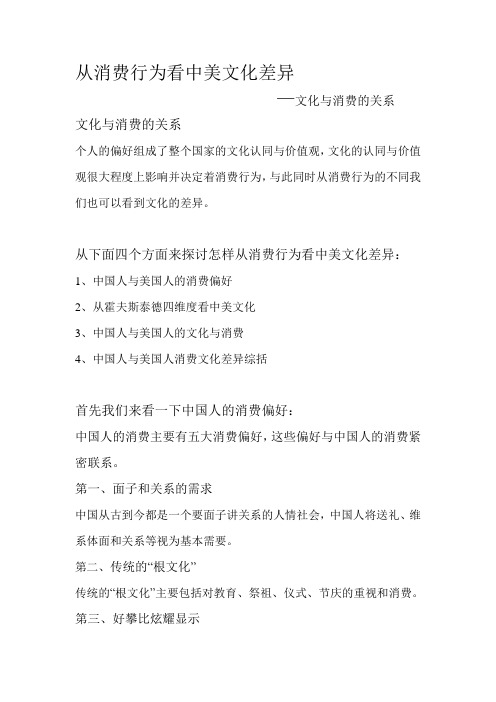
从消费行为看中美文化差异—文化与消费的关系文化与消费的关系个人的偏好组成了整个国家的文化认同与价值观,文化的认同与价值观很大程度上影响并决定着消费行为,与此同时从消费行为的不同我们也可以看到文化的差异。
从下面四个方面来探讨怎样从消费行为看中美文化差异:1、中国人与美国人的消费偏好2、从霍夫斯泰德四维度看中美文化3、中国人与美国人的文化与消费4、中国人与美国人消费文化差异综括首先我们来看一下中国人的消费偏好:中国人的消费主要有五大消费偏好,这些偏好与中国人的消费紧密联系。
第一、面子和关系的需求中国从古到今都是一个要面子讲关系的人情社会,中国人将送礼、维系体面和关系等视为基本需要。
第二、传统的“根文化”传统的“根文化”主要包括对教育、祭祖、仪式、节庆的重视和消费。
第三、好攀比炫耀显示在中国深远的要面子讲关系的文化中,攀比和炫耀显示身份就无疑成为中国人的典型消费特征。
第四、收入较低价格敏感中国经济处于发展中,大多数人收入较低,消费时对价格表现敏感。
第五、物质享受主义中国人注重吃穿住行等物质上的享受,对精神上的享受需求较少。
看完中国人的消费偏好后我们再来看下美国人的消费偏好:美国人的消费偏好主要表现在图上的六大点:第一、赶时髦、猎新奇美国人天性“喜新厌旧”,对旧和老都很忌讳,在消费上追求时髦和新奇。
第二、讲健康、求自然美国人生活水平高,故特别重视对健康的投资;同时美国人生活在一个机械化时代和人造物品的环境中,因而希望返璞归真、回归自然。
第三、追求个性、要高档美国人个性极强,并喜欢在消费生活中表现,并且收入较高,就决定了美国人追求个性要高档的消费特征。
第四、图方便、追求情趣美国是一个高度现代化国家,生活节奏快和忙碌,死板而缺乏情趣,因此消费时对方便和情趣追求要求比较大。
第五、借债消费、超前消费美国拥有完善的信用制度,美国人大部分都是通过借债还债方式进行消费的。
第六、季节性消费美国人消费具有很强的季节性,每个大型节日都是美国市场的销售旺季。
中西方购物差异
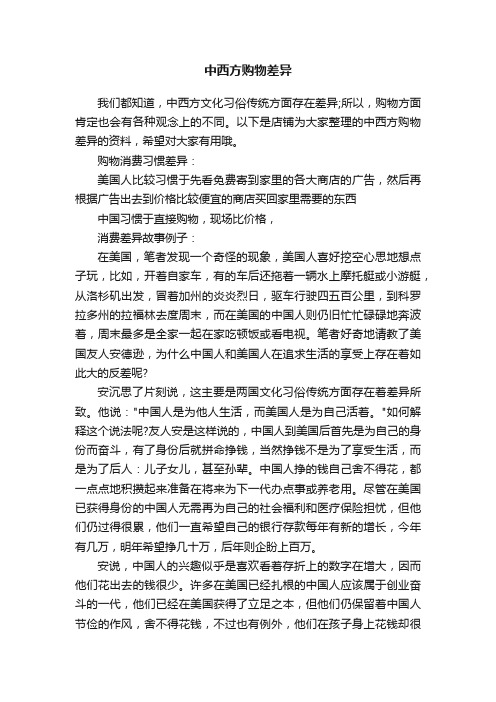
中西方购物差异我们都知道,中西方文化习俗传统方面存在差异;所以,购物方面肯定也会有各种观念上的不同。
以下是店铺为大家整理的中西方购物差异的资料,希望对大家有用哦。
购物消费习惯差异:美国人比较习惯于先看免费寄到家里的各大商店的广告,然后再根据广告出去到价格比较便宜的商店买回家里需要的东西中国习惯于直接购物,现场比价格,消费差异故事例子:在美国,笔者发现一个奇怪的现象,美国人喜好挖空心思地想点子玩,比如,开着自家车,有的车后还拖着一辆水上摩托艇或小游艇,从洛杉矶出发,冒着加州的炎炎烈日,驱车行驶四五百公里,到科罗拉多州的拉福林去度周末,而在美国的中国人则仍旧忙忙碌碌地奔波着,周末最多是全家一起在家吃顿饭或看电视。
笔者好奇地请教了美国友人安德逊,为什么中国人和美国人在追求生活的享受上存在着如此大的反差呢?安沉思了片刻说,这主要是两国文化习俗传统方面存在着差异所致。
他说:"中国人是为他人生活,而美国人是为自己活着。
"如何解释这个说法呢?友人安是这样说的,中国人到美国后首先是为自己的身份而奋斗,有了身份后就拼命挣钱,当然挣钱不是为了享受生活,而是为了后人:儿子女儿,甚至孙辈。
中国人挣的钱自己舍不得花,都一点点地积攒起来准备在将来为下一代办点事或养老用。
尽管在美国已获得身份的中国人无需再为自己的社会福利和医疗保险担忧,但他们仍过得很累,他们一直希望自己的银行存款每年有新的增长,今年有几万,明年希望挣几十万,后年则企盼上百万。
安说,中国人的兴趣似乎是喜欢看着存折上的数字在增大,因而他们花出去的钱很少。
许多在美国已经扎根的中国人应该属于创业奋斗的一代,他们已经在美国获得了立足之本,但他们仍保留着中国人节俭的作风,舍不得花钱,不过也有例外,他们在孩子身上花钱却很大方。
不少中国人有这样的心态,自己这一代创业时吃尽了苦,因此,应该让孩子生活得更好些。
所以,在美国小学里,人们可以看到那些穿得最好的,口袋里零花钱最多的是中国人的小孩,而正宗的美国孩子穿着是很普通的,口袋里也没有多少零花钱。
中美消费倾向的比较分析

中美消费倾向的比较分析中美消费倾向的比较分析在现实生活中,影响各个家户消费的因素很多,如收入水平、商品价格水平、利率水平、收入分配状况、消费者为偏好、家庭财产状况、消费信贷状况、消费者年龄构成、社会保障制度、风俗习惯等等。
凯恩斯认为,这些因素中有决定意义的是家户收入。
关于收入和消费的关系,凯恩斯认为,存在一条基本心理规律:随着收入的增加,消费也会增加,但是消费的增加不及收入增加多,消费和收入的这种关系称作消费函数或消费倾向。
消费函数理论所指出的,消费主要取决于收入,但这种收入并不实现现期收入,而是一生的收入或持续三年以上的固定持久收入。
决定一生收入或持久收入的是未来收入的预期。
这就是说,人们的收入预期越稳定,消费支出越多。
相反,即使现在收入水平高,但如果未来预期收入不确定性高,那么,人们也不敢增加消费,而要把部分收入储蓄起来,以防患于未然。
据估算,美国的消费倾向即消费支出在可支配收入中的比例,约为0.68,而中国的消费倾向是0.48。
也许这种估算不一定十分准确,但是一个不争的事实是,中国的消费倾向低于美国。
为什么中美消费倾向有这种差别呢?一些人认为,这种差别在于中美两国的消费观念不同。
有这样一个故事讲到中美两国人在消费观念上的不同,说是一个中国老太太和一个美国老太太在天堂相遇,谈起了在人间的一生。
美国老太太说:“我辛苦了三十年,终于把住房贷款都还清了。
”中国老太太说:“我辛苦了三十年,终于攒够了买房的钱。
”美国老太太在自己买的房子里住了三十年,后半生都在还款;而中国老太太后半生一直在存款攒钱,刚攒够了买房的钱,却去了天堂,无福享受自己买的新房。
美国人崇尚享受,今天敢花明天的钱,中国有节俭的传统,一分钱要掰成两瓣花。
在经济学家看来,消费观念属于伦理道德的范畴,有经济基础决定。
所以,不能用消费观念去解释这种差别,而要从经济的角度分析不同消费观念的经济原因。
首先看收入。
美国是一个成熟的市场经济国家,尽管也经常发生经济周期性波动,但经济总体上是稳定的。
中美消费文化的差异之浅析
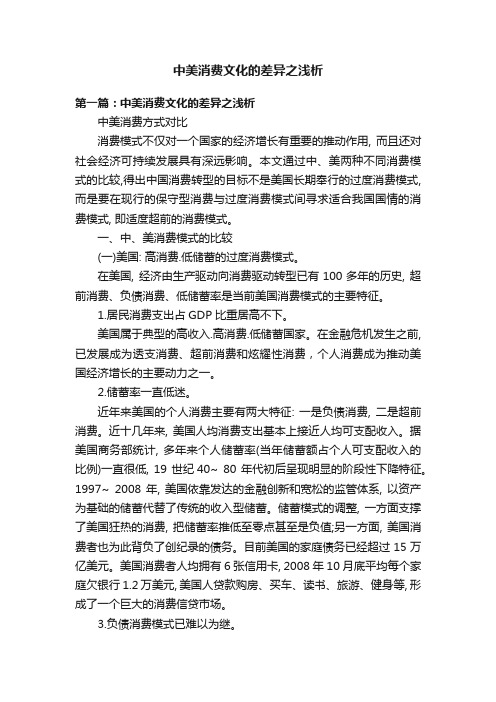
中美消费文化的差异之浅析第一篇:中美消费文化的差异之浅析中美消费方式对比消费模式不仅对一个国家的经济增长有重要的推动作用, 而且还对社会经济可持续发展具有深远影响。
本文通过中、美两种不同消费模式的比较,得出中国消费转型的目标不是美国长期奉行的过度消费模式, 而是要在现行的保守型消费与过度消费模式间寻求适合我国国情的消费模式, 即适度超前的消费模式。
一、中、美消费模式的比较(一)美国: 高消费.低储蓄的过度消费模式。
在美国, 经济由生产驱动向消费驱动转型已有100多年的历史, 超前消费、负债消费、低储蓄率是当前美国消费模式的主要特征。
1.居民消费支出占GDP比重居高不下。
美国属于典型的高收入.高消费.低储蓄国家。
在金融危机发生之前, 已发展成为透支消费、超前消费和炫耀性消费,个人消费成为推动美国经济增长的主要动力之一。
2.储蓄率一直低迷。
近年来美国的个人消费主要有两大特征: 一是负债消费, 二是超前消费。
近十几年来, 美国人均消费支出基本上接近人均可支配收入。
据美国商务部统计, 多年来个人储蓄率(当年储蓄额占个人可支配收入的比例)一直很低, 19 世纪40~ 80 年代初后呈现明显的阶段性下降特征。
1997~ 2008 年, 美国依靠发达的金融创新和宽松的监管体系, 以资产为基础的储蓄代替了传统的收入型储蓄。
储蓄模式的调整, 一方面支撑了美国狂热的消费, 把储蓄率推低至零点甚至是负值;另一方面, 美国消费者也为此背负了创纪录的债务。
目前美国的家庭债务已经超过15万亿美元。
美国消费者人均拥有6张信用卡, 2008年10月底平均每个家庭欠银行1.2万美元, 美国人贷款购房、买车、读书、旅游、健身等, 形成了一个巨大的消费信贷市场。
3.负债消费模式已难以为继。
长期以来,上至美国政府, 下至企业和消费者, 都以不同的借贷方式度日。
美国政府主要通过财政赤字, 消费者主要靠借债来支撑消费。
本次国际金融危机导致发达经济体特别是美国的消费者即期收入减少, 资产大幅缩水。
从价值观角度分析中美消费观念的不同

从价值观角度分析中美消费观念的不同摘要:价值观是文化的核心,它深刻影响着某一文化群体里人们的思想和观念。
在中美两个不同的文化群体里,人们形成了不同的价值观,其消费观念在住房消费、科技产品消费和服装消费三个方面也存在较大差异。
从价值观角度出发分析中美消费观念的差异及其内在联系,有助于理解中美消费观念的不同,并有利于对其做出合理的解释。
关键词:价值观;消费观念;中美差异中图分类号:g04 文献标识码:a 文章编号:1009-0118(2012)-06-0-02一、引言在不同的历史文化背景下,人们形成了不同的价值观,价值观是决定文化特征的潜在力量,影响着文化群体里人们的思想和观念。
在以往有关价值观对跨文化交际影响的研究中,理论研究居多。
如对跨文化交际中价值观差异的研究(刘立娥,2008;袁在成,2011);也有个别的研究与某一具体的交际行为相结合,如中美价值观的不同对社交称谓语差异的影响研究(王静,2010)。
然而,却很少有学者从价值观角度分析中美消费观念的不同,因此,本文将就这一话题从住房消费、科技产品消费和服装消费三个方面分析中美消费观念的差异,并探讨价值观在其中的作用,以期起到抛砖引玉之功效。
二、价值观价值观是社会意识形态的组成部分,是文化的核心,价值观的习得是在社会化的过程中完成的。
正如胡文仲(1999:168)所言,“价值观一旦形成,便支配着人们的信念、态度、看法和行为,成为人们行动的指南。
”价值观对一个国家而言,是这个国家或民族在历史发展中逐步形成的一种价值取向,而后“变成他们的集体无意识,变成他们的信仰、心态、行为、生活等方面的可评价体系,变成他们民族性格的基石”(贾玉新,1997:59)。
不同国家或民族在文化交流和相互渗透的过程中,价值观的差异必然引起各种文化思想的碰撞。
hofstede(1991:46)曾针对不同文化群体的价值观提出四种价值维度:集体主义-个人主义(collectivism-individualism)、对不确定因素的回避程度(uncertainty avoidance)、权力距离(power distance)、男性主义和女性主义(masculinity and femininity)。
美国和中国的消费文化有何异同?
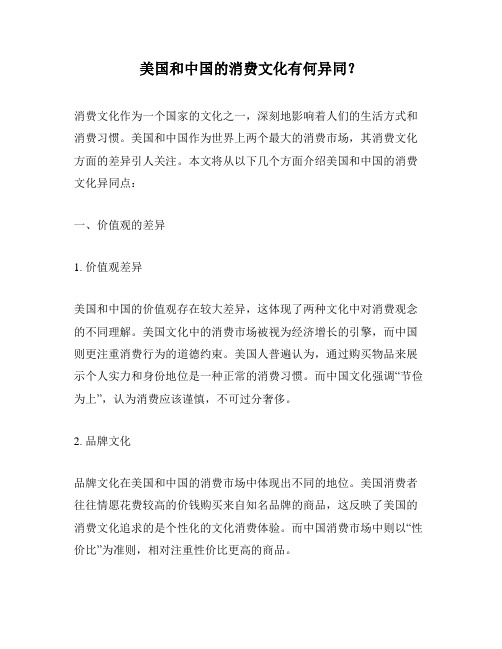
美国和中国的消费文化有何异同?消费文化作为一个国家的文化之一,深刻地影响着人们的生活方式和消费习惯。
美国和中国作为世界上两个最大的消费市场,其消费文化方面的差异引人关注。
本文将从以下几个方面介绍美国和中国的消费文化异同点:一、价值观的差异1. 价值观差异美国和中国的价值观存在较大差异,这体现了两种文化中对消费观念的不同理解。
美国文化中的消费市场被视为经济增长的引擎,而中国则更注重消费行为的道德约束。
美国人普遍认为,通过购买物品来展示个人实力和身份地位是一种正常的消费习惯。
而中国文化强调“节俭为上”,认为消费应该谨慎,不可过分奢侈。
2. 品牌文化品牌文化在美国和中国的消费市场中体现出不同的地位。
美国消费者往往情愿花费较高的价钱购买来自知名品牌的商品,这反映了美国的消费文化追求的是个性化的文化消费体验。
而中国消费市场中则以“性价比”为准则,相对注重性价比更高的商品。
二、消费模式的不同1. 线上销售随着互联网技术的发展,线上销售成为了全球消费市场的重要形式。
对于美国和中国两个消费大国,线上购物渠道的发展也不尽相同。
在美国,电商巨头亚马逊和沃尔玛等零售商占据了主要的线上销售市场。
而在中国,电商平台阿里巴巴旗下淘宝和天猫则成为了重要线上销售渠道。
2. 服务业消费这方面,则体现了两国经济质量不同的差异。
在美国,服务业占据了主导地位,大多消费者更愿意为高质量的服务买单。
而在中国,由于经济产业结构还尚未完全转型,以服务业为主导的消费市场基础不够稳定。
三、消费行为的差异1. 消费场景的区别美国和中国消费场景的差异,从某种程度上反映了两国不同的生活方式和消费倾向。
在美国,消费市场主要集中在购物中心等线下销售场景中,开车到店铺购物是一种常见的消费行为。
而在中国,购物中心与电影院、餐厅等多种消费场景集成为复合式消费中心,强调的是全场地复合式消费体验。
2. 社交消费与个人消费的差异在美国,社交消费比较普遍,由于强调个性化体验,所以社交性消费也更注重于社交场景的体验感。
中美消费观念的差异

浅析中美消费观念的差异研究消费观,首先应理解什么是消费。
我国专门研究消费问题的消费经济辞对消费的定义是:“人们通过对各种劳动产品的使用和消耗,以满足自己需要的行为和过程。
”消费包括生产性消费和生活消费。
消费观则是人们对消费水平、消费方式和消费行为等问题的总的态度和看法,它影响人们的消费行为,是社会经济现实在人们头脑中的反映,其一旦形成又反作用于社会经济,并对其产生深刻而重大的影响。
三种有重大影响的消费观——节俭消费观、侈糜消费观和适度消费观.1节俭消费观就是主张人们在消费时应最大限度地节约物质财富,减少甚至杜绝浪费的一种消费观。
这是人类历史上形成最早、影响最深、历时最长的一种消费观。
可以说,自人类产生到时至今日,这种消费观都或多或少、或强或弱地影响着人们的消费行为和消费方式。
2这是一种与节俭消费观完全对立的消费观,与经济发展水平以及自身经济状况不相适应的消费观。
它主张消费者大量地、无节制地占有和消耗物质财富,以满足自身的需求和欲望。
这种消费观不仅在发达资本主义国家得到了普遍的认可和广泛的推行,而且也向发展中国家不断传播和扩散,成为影响这些国家消费观念和消费行为的重要因素。
3适度消费观是一种既吸收了上述两种消费观的合理因素,又屏弃了它们的消极因素的消费观;是一种既不主张对物质财富一味节约吝惜,又不赞成对物质财富毫无节制的消耗滥用的消费观;是一种使消费者既不为清贫所迫,又不为物质所累的消费观。
消费观念有两种对立的形态。
一种是主张节俭的,一种是主张消费的。
崇尚节俭的国家以中国为代表,而美国就是典型的主张消费的国家。
中国和美国都是目前在全球经济发展中发挥着重要作用的国家,但储蓄与消费的运行轨迹截然不同:存款过度与负债累累,形成了鲜明反差。
.美国:高消费一低储蓄的过度消费模式在美国,经济由生产驱动向消费驱动转型已有100多年的历史,超前消费、负债消费、低储蓄率是当前美国消费模式的主要特征。
居民消费支出占GDP比重居高不下,而且个人储蓄率一直低迷甚至为负数。
中美消费观有什么不同
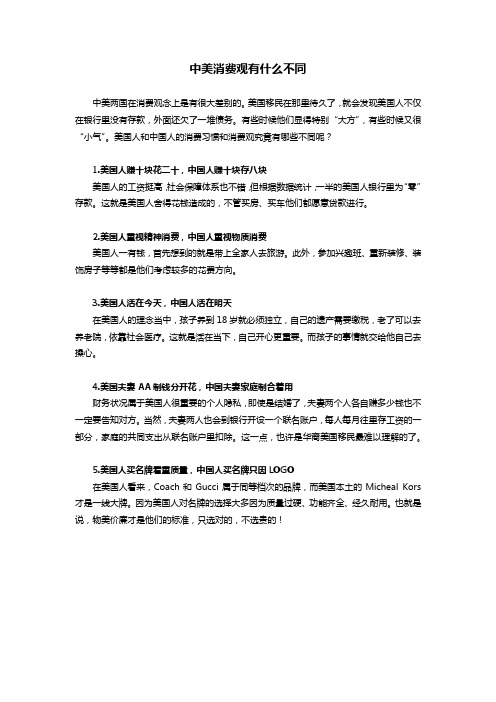
中美消费观有什么不同
中美两国在消费观念上是有很大差别的。
美国移民在那里待久了,就会发现美国人不仅在银行里没有存款,外面还欠了一堆债务。
有些时候他们显得特别“大方”,有些时候又很“小气”。
美国人和中国人的消费习惯和消费观究竟有哪些不同呢?
1.美国人赚十块花二十,中国人赚十块存八块
美国人的工资挺高,社会保障体系也不错,但根据数据统计,一半的美国人银行里为“零”存款。
这就是美国人舍得花钱造成的,不管买房、买车他们都愿意贷款进行。
2.美国人重视精神消费,中国人重视物质消费
美国人一有钱,首先想到的就是带上全家人去旅游。
此外,参加兴趣班、重新装修、装饰房子等等都是他们考虑较多的花费方向。
3.美国人活在今天,中国人活在明天
在美国人的理念当中,孩子养到18岁就必须独立,自己的遗产需要缴税,老了可以去养老院,依靠社会医疗。
这就是活在当下,自己开心更重要。
而孩子的事情就交给他自己去操心。
4.美国夫妻AA制钱分开花,中国夫妻家庭制合着用
财务状况属于美国人很重要的个人隐私,即使是结婚了,夫妻两个人各自赚多少钱也不一定要告知对方。
当然,夫妻两人也会到银行开设一个联名账户,每人每月往里存工资的一部分,家庭的共同支出从联名账户里扣除。
这一点,也许是华裔美国移民最难以理解的了。
5.美国人买名牌看重质量,中国人买名牌只因LOGO
在美国人看来,Coach和Gucci属于同等档次的品牌,而美国本土的Micheal Kors 才是一线大牌。
因为美国人对名牌的选择大多因为质量过硬、功能齐全、经久耐用。
也就是说,物美价廉才是他们的标准,只选对的,不选贵的!。
中美消费习俗的异同

姓名:刘晓庆学号:20130209016 专业:知识产权课程:管理学中美消费习俗的异同任何一种消费者行为的产生都是与其外部环境及内部环境息息相关的。
而中美之间的内、外部环境有很大的差异,因此中美两国的居民消费者行为特征自然会有很大的不同。
2010年中国超过日本成为GDP仅次于美国的全球第二大国家,从表面上来看应该说是一件喜事,但是其实际意义不大,而且我们中国政府对此反应也相当低调。
中美两国作为对全球局势走向起着举足轻重的两个大国强国,但两个国家国民的消费习惯却有着巨大的差异。
首先,文化习俗方面。
中国是世界四大文明古国之一,并且其文明从发源以来至今从未中断过,其他三个国家是没有过的。
灿烂的文明使我们为之自豪。
五千年来悠久文明使得中国人就形成了一种以“勤劳节约光荣,铺张浪费耻辱”的意识。
有很多诗歌谚语之类的文化作品都能反映出来,例如古代诗歌《悯农》的“谁知盘中餐,粒粒皆辛苦”就清晰地描绘出了古人那种节约意识。
并且以儒家文化为代表,教育的是人们怎么修身养性。
中国消费者在传统观念的影响下,个人的物质欲望往往受到压抑。
如中国传统观念主张“谦、良、恭、俭、让”,在其影响下,勤俭消费成为大多数中国人所奉行的消费观念,这一观念虽然在现在受到消费主义和享乐主义的冲击,但它依然是中国消费者所普遍持有和坚持的观念。
在勤俭节约的观念的影响和支配下,消费者的需求,特别是高档奢侈产品和服务的需求及其增长会相对受到限制,消费者在购买中也会更多地重视产品和服务的实际效用和价值,反对盲目攀比和铺张浪费。
而美国人不是这样,至少美国人敢花钱,他们崇尚消费,他们的历史文化积淀使得美国人向众多西方人那样有着勇敢和冒险的鲜明特点(这并不是说我们中国人就不勇敢)。
他们受之前的中世纪文艺复兴和启蒙运动的巨大影响。
美国消费者具有很强的自我观念,信奉的是为自己而活,一切都是为了自己生活得更好。
因此,美国人挣钱的动力是为了享受生活,追求更高品质的生活质量,美国国民的观念中并不存在勤俭这一意识。
浅析中西方主流消费理念差异

浅析中西方主流消费理念差异作者:周霞杜孝文来源:《读与写·中旬刊》2017年第09期摘要:中西方在主流文化、主流思想以及教育方式等方面存在着巨大的差异,而这些差异又是造成中西方消费理念不同的重要因素。
通过深入探讨造成中西方消费理念差异,可有助于更好地形成一种健康、合理的消费理念。
关键词:中西方;主流文化;主流思想;教育方式;消费理念中图分类号:G648文献标识码:B文章编号:1672-1578(2017)09-0015-01自改革开放以来,中国确立了以经济建设为中心的发展方针,并进入了一场从经济领域开始但却绝不仅仅限于经济领域的伟大变革。
与西方社会自下而上的现代化进程所不同的是,中国的现代化进程是由国家主导且充满中国特色的,中国目前仍处于转型期,在这一时期,中国社会将会经历社会经济结构的转换,社会体制的不断更新,社会利益认同以及社会价值观念的转变。
在众多影响中西方消费理念的因素中,主流文化、主流思想以及教育方式等的作用尤为突出。
1.中西主流思想差异对消费理念的影响勤俭节约是中国历来的传统美德之一,同时也是中国主要的消费理念,这是由于古代中国以农耕社会为主,绝大多数的人们处于社会最底层,不仅要面对繁重的徭役,还要祈祷上天的眷顾,天灾人祸不断导致物质财富的极大匮乏。
然而在重农轻商的思想之下,商品经济的发展缓慢甚至停滞。
不仅如此,老百姓经济实力弱小,经济购买力不足等使得人民生活水平较低,从而勤俭节约也就成为了中华民族延续上千年的优良传统。
勤俭节约的思想导致了中国消费者谨慎消费的理念,尤其体现在对高端奢侈品的较低消费意向,追求物美价廉的消费占据主导地位,并制约着国人的消费行为。
与消费相比,中国人更倾向于攒钱的行为也是受制于此思想。
西方的消费理念恰恰与中国勤俭节约的消费理念相反,自文艺复兴以后,西方世界开始鼓吹解放人类天性,崇尚自由,主张及时行乐,财产乃是身外之物。
另外,欧洲的海洋性气候适宜,地形地势平坦,天灾较少,畜牧业高度发达,商品经济蓬勃发展,人民购买力强,公民的个人自我意识较强,在这种及时行乐的思想下,西方消费者有钱便用来消费,没钱也会通过借贷等方式提前消费。
